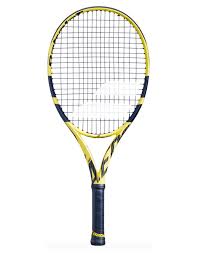Long ago, string patterns were changed a lot on the tennis racquet.
The companies who manufacture the string patterns on the racquets always research and then draw the way by keeping in mind what would be the effects of these string patterns while playing.
Do you know what a string pattern is? A tennis racquet string patterns is a combination of up-down string and cross strings in a racquet. There are several string patterns, but the main ones are 18 × 20, 16 x 19, 16 x 20, and 16 x 18.

It is almost possible to change a pattern of a racquet, but only a few can be exceptional. Have you ever heard of dense patterns and the open pattern? No? No worries. Let us tell you what these terms mean. A dense pattern is a small space between the strings on a racquet.
An open pattern is known as the broader separation of lines. As we have said, you will see plenty of patterns, but we have listed a few that are well-known.
Tennis Racquet String Patterns Explained
18 X 20 String

Let’s begin by examining the game’s two most common string patterns today! The first string pattern is 18 x 20. The player has more control, and the strings are more durable with this pattern as there are 18 mains (verticals) and 20 crosses (horizontals).
As a result of the string pattern being denser, it is possible to strike more strings on impact with a much stronger shot.
There have been 18 x 20 strings for a while; however, they do not produce quite as much spin as other patterns. This is because 18 x 20 strings provide flat-hitting players with better directional control on the court.
The popularity of this string pattern has declined over the years. Previously, natural gut strings needed the 18 x 20 pattern to be controlled, but today different string materials can provide control even with an open pattern. There are more strings to deflect in a denser pattern, so tensions are generally lower.
16 X 19 String Pattern

The most common tight pattern used on racquets is known as 16 x 19 string. You will see this pattern in most of the head racquet stringing patterns.
It is a little more open pattern than the 18 x 20 string. That’s why it can give extra spin and power quickly. Its ability to increase strength and feel for the ball at impact may appeal to some players slightly more than the 16 x 19.
The ball can then easily be hit deep into the court to keep the opponents at bay. Tension control and string durability are the two drawbacks of this pattern. String breaks or restringing of racquets is more common among players who use this pattern.
16 X 18 Patterns

The 16 x 18 pattern is similar to the 16 x 19 string but comes with more power and spin. The pattern becomes more open because there are fewer cross strings, allowing the ball to flex in the stringbed and stay on the strings for extended periods. Using heavier spin, players can hit the ball deeper into the court without worrying about losing control of the ball.
As a result, string tension and durability diminish faster, which leads to more frequent restringing. There will be more density in the sweet spot of these rackets, and they will open up more toward the outer edges.
16 X 20 String Pattern

16 x 20 has similarities to the two most popular string patterns, the 16 x 19 and the 18 x 20. The string snaps back well because there are fewer mains, and the dense crosses provide better stability. The 16 x 20 will not be as weak as other patterns, even though it does not generate quite so much spin. Racquets with this pattern will have a more tight sweet spot and open more towards the outer edges.
Open String Pattern

An open string pattern comes, providing more spin and power than all other patterns. There are many varieties of string in the open pattern including 14 x 18, 16 x 16, 18 x 16, 16 x 15, and 18 x 17. Tennis racquets with 16 x 15, 18 x 16, and 18 x 17 string patterns, and Wilson Spin effect technology, increase ball speed by as much as 200 RPM.
Thus, the strings are 3.3 times more mobile and snap back 69% faster before the ball leaves. As a result, you may feel the impact as being softer and have more power and feel on the ball. The constant movement during hitting will, however, cause strings to break more frequently on these patterns, and strings will also lose control more often.
Also Read>> Semi-Western Forehand Grip
Benefits of Different String n Swing Patterns
Different string patterns have additional benefits, including more spin, power, and ease of playing. Here we will discuss a few benefits of the racquet string pattern.
Spin
There is a greater chance of biting the ball when more space between the strings. The open pattern, therefore, can enhance spin, and because topspin is such an essential part of the game, companies construct frames with specific patterns that specifically cater to it. It is still possible to spin the ball with a dense pattern, but it may be more difficult. A stiffer string bed and greater surface area increase directional control.
Comfort
If you have two similar-sized frames with the exact string count and tension, you will usually experience a softer, more arm-friendly response with a more open string pattern with the racquet. Additionally, the ball can dwell on a string bed for extended periods, producing a higher launch point and easier shots. As little as 15 cross strings can be used in the frame of a 16×18 or 16×19 pattern that used to be considered open before.
The string bed provides a firmer response to racquets with more strings, but more series makes the racquet stiffer. The dense string frames pattern categories with 16×20 and 18×20 configurations. These racquets can be preferable and more pleasing to players who control the ball with lots of touch and precision than racquets with open patterns that are elevated to a softness that is “enhanced.”.
Longevity of String
You weaken and eventually snap your strings when you hit a ball because your strings rub against each other every time you hit. Breakage is more likely to occur when there is more room for movement, the more open the string pattern.
Spring Breakers avoid those types of frames entirely, which explains why they often break strings during games. Tighter string patterns have fewer places for strings to move, which leads to longer string life. Open string patterns also allow players to use softer and thinner strings, which would break much more quickly.
Also Read>> How to wash tennis shoes
FAQs
What is the best string pattern for a tennis racket?
16 X 19 is the most common and best pattern on tennis racquets nowadays.
How does a string pattern affect a tennis racquet?
String life is better with a dense string pattern, which reduces string movement. A-frame with an open string pattern would break much faster with softer or thinner strings.
What is Federer’s string pattern?
Throughout Federer’s career, he has tended to use the same kind of strings. Wilson Natural Gut strings are used in the crosses and Luxilon Alu Power Rough 16L in the mains. Wilson offers a Champion’s Choice Duo package with both of these in one.
Final Thoughts
We have tried to give you information about the tennis racquet string patterns. This article contains information about types of string patterns, what they mean, and how they are beneficial for you. We hope you will find this information valuable. If you like our content, don’t forget to share it with your loved ones.


